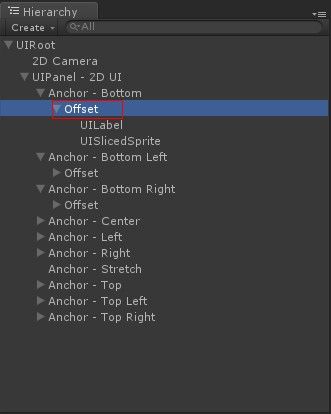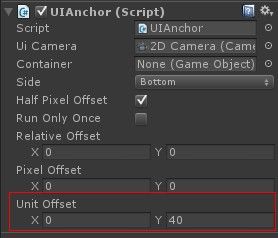NGUI所见即所得之UIAnchor & UIStretch
NGUI的Example/Scenes/Example1介绍的主要就是UIRoot,UIAnchor和UIStretch这三个脚本,当然UIRoot是每个UI都会有的(挂在根节点),之前D.S.Qiu也写过博客介绍过UIRoot(猛点查看)。一直都对NGUI把Unity的单位和像素的转换和统一都很有疑惑,因之手游项目要做UI的自适应,就觉得很有必要把UIAnchor和UIStretch深入的研究下。
UIRoot在D.S.Qiu的第一篇NGUI的文章中介绍了(猛点查看),UIRoot其实就做了一件事情:根据Screen.height和UIRoot.activeHeight的比例来调整UIRoot的loaclScal,从而保证UIWidget(UISprite,UILabel)可以按照其本身的大小进行设置,而不用经过复杂的换算过程。
UIAnchor和UIStretch处理上的细节很相似,都是先计算参照对象(这个参照对象由Insprector的Container指定,如果没有选择,就是Camera)的大小Rect,然后根据参数UIAnchor(Side,relativeOffset,pixelOffset),UIStretch(Style,relativeSize,initialSize,borderPadding)进行调整,最后设置对应的属性,只不过UIAnchor设置的是transform.position,UIStretch设置的是(width,height)或clipRange等。
UIAnchor
先看下UIAnchor的Inspector界面,感觉很简单,不会像UIPanel那么复杂:
Container:指定Anchor的参照点,如果没有选择,则以Camera的pixelRect的区域为参照面
Side:Anchor的定位方式
Relative Offset:相对于Camera,或Container的百分比偏移
Pixel Offset:像素的偏移
/// <summary> /// Relative offset value, if any. For example "0.25" with 'side' set to Left, means 25% from the left side. /// </summary> public Vector2 relativeOffset = Vector2.zero; /// <summary> /// Pixel offset value if any. For example "10" in x will move the widget 10 pixels to the right /// while "-10" in x is 10 pixels to the left based on the pixel values set in UIRoot. /// </summary> public Vector2 pixelOffset = Vector2.zero;
Update函数
UIAnchor的主要功能实现都在Update函数:
void Update ()
{
if (mAnim != null && mAnim.enabled && mAnim.isPlaying) return;
bool useCamera = false;
UIWidget wc = (container == null) ? null : container.GetComponent<UIWidget>();
UIPanel pc = (container == null && wc == null) ? null : container.GetComponent<UIPanel>();
if (wc != null)
{
Bounds b = wc.CalculateBounds(container.transform.parent);
mRect.x = b.min.x;
mRect.y = b.min.y;
mRect.width = b.size.x;
mRect.height = b.size.y;
}
else if (pc != null)
{
if (pc.clipping == UIDrawCall.Clipping.None)
{
// Panel has no clipping -- just use the screen's dimensions
float ratio = (mRoot != null) ? (float)mRoot.activeHeight / Screen.height * 0.5f : 0.5f;
mRect.xMin = -Screen.width * ratio;
mRect.yMin = -Screen.height * ratio;
mRect.xMax = -mRect.xMin;
mRect.yMax = -mRect.yMin;
}
else
{
// Panel has clipping -- use it as the mRect
Vector4 pos = pc.clipRange;
mRect.x = pos.x - (pos.z * 0.5f);
mRect.y = pos.y - (pos.w * 0.5f);
mRect.width = pos.z;
mRect.height = pos.w;
}
}
else if (container != null)
{
Transform root = container.transform.parent;
Bounds b = (root != null) ? NGUIMath.CalculateRelativeWidgetBounds(root, container.transform) :
NGUIMath.CalculateRelativeWidgetBounds(container.transform);
mRect.x = b.min.x;
mRect.y = b.min.y;
mRect.width = b.size.x;
mRect.height = b.size.y;
}
else if (uiCamera != null)
{
useCamera = true;
mRect = uiCamera.pixelRect;
}
else return;
float cx = (mRect.xMin + mRect.xMax) * 0.5f;
float cy = (mRect.yMin + mRect.yMax) * 0.5f;
Vector3 v = new Vector3(cx, cy, 0f);
if (side != Side.Center)
{
if (side == Side.Right || side == Side.TopRight || side == Side.BottomRight) v.x = mRect.xMax;
else if (side == Side.Top || side == Side.Center || side == Side.Bottom) v.x = cx;
else v.x = mRect.xMin;
if (side == Side.Top || side == Side.TopRight || side == Side.TopLeft) v.y = mRect.yMax;
else if (side == Side.Left || side == Side.Center || side == Side.Right) v.y = cy;
else v.y = mRect.yMin;
}
float width = mRect.width;
float height = mRect.height;
v.x += pixelOffset.x + relativeOffset.x * width;
v.y += pixelOffset.y + relativeOffset.y * height;
if (useCamera)
{
if (uiCamera.orthographic)
{
v.x = Mathf.Round(v.x);
v.y = Mathf.Round(v.y);
if (halfPixelOffset && mNeedsHalfPixelOffset)
{
v.x -= 0.5f;
v.y += 0.5f;
}
}
v.z = uiCamera.WorldToScreenPoint(mTrans.position).z;
v = uiCamera.ScreenToWorldPoint(v);
}
else
{
v.x = Mathf.Round(v.x);
v.y = Mathf.Round(v.y);
if (pc != null)
{
v = pc.cachedTransform.TransformPoint(v);
}
else if (container != null)
{
Transform t = container.transform.parent;
if (t != null) v = t.TransformPoint(v);
}
v.z = mTrans.position.z;
}
// Wrapped in an 'if' so the scene doesn't get marked as 'edited' every frame
if (mTrans.position != v) mTrans.position = v;
if (runOnlyOnce && Application.isPlaying) Destroy(this);
}
Update的原理很简单,梳理归纳为4部分:
1)获取Anchor参照对象的大小Rect以及计算中心点Vector3 v;
2)根据Side类型调整v的x,y,z值;
3)将v转换成世界坐标
4)将v赋给mTrans.position。
这里对1)再多说几句,主要是涉及参照对象的选取问题,用if - else if来筛选的次序是 UIWidget wc , UIPanel pc , GameObject container, Camera uiCamera,如果前者部位null这取前者的大小后面的就不予考虑。
UIWidget wc = (container == null) ? null : container.GetComponent<UIWidget>(); UIPanel pc = (container == null && wc == null) ? null : container.GetComponent<UIPanel>();
像素与Unity单位
之前项目中使用的NGUI版本还是2.6.3,那个版本还没有pixelOffset,然后为了实现一个相对便宜就在挂载Anchor的对象下面挂载一个子对象,通过设置子对象的loaclPosition来设置相对偏移:

这样用transform.find去查找某一个子对象的时候就会觉得很蛋疼,所以当看到pixelOffset的就觉得没有必要用offset这层节点了,这可以说是NGUI埋下隐形的坑(很多没有“爱参考”不思考的开发者,就喜欢照搬别人的东西),之前的项目就是这样的,看了一堆Offset,完全没有必要。然后果断测试就会有以下不同的情况。
测试之前首先将上面Bottom/Offset的localPosition置0,并修改稿Bottom的UIAnchor的pixelOffset改为(0,40)
1)当参照对象是Camera时,即Container=null:
但当编辑器的分辨率等于某个值时,又回恢复正常情况:
2)把Bottom的父对象UIPanel拖给UIAnchor的Container:
这种情况是没有问题的:
回过头看下Update函数中对pixelOffset的使用:
v.x += pixelOffset.x + relativeOffset.x * width; v.y += pixelOffset.y + relativeOffset.y * height;
经过反复的思考,觉得一定是pixelOffset和子对象Offset的localPosition数值的参考系是不一样的,但最终都是通过mRect来处理的,所以把UIAnchor Rect mRect设置成public,查看mRect的值,上面三个情况对应mRect值分别如下:


这说明,当mRect.y大于等于800的时候,使用UIAnchor的pixelOffset和使用子对象Offset的localPosition的表现是一致的。但为什么指定Container为UIPanel都不会出现异常情况,只有Camera会出现。再回到Update看下获取mRect的方法,指定Container时,mRect实际是UIPanel,或UIWideget的像素大小,其实是UIWidget的(width,height),而没有指定Container情况下,mRect = camera.pixelRect。
在UIRoot文中,就说过camera.pixelRect其实就是Screen的(width,height),也就是说,camera.pixelRect是会根据显示器的分辨率动态改变的,而指定Container时,mRect是不会改变的(在介绍UIRoot文中有介绍)。
在看下pixelOffset的使用(真的是最后一次了):
v.x += pixelOffset.x + relativeOffset.x * width; v.y += pixelOffset.y + relativeOffset.y * height;
虽然pixelOffset的值一直没有变化,但是当mRect = camera.pixelCamera时,mRect是随着分辨率的变化而变化的,那样的话pixelOffset占的权重就会改变了,所以才会出现上面的偏移异常。
解决策略
在UIAnchor中设置一个参数unitOffset来代替子对象Offset的功能:
public Vector2 unitOffset = Vector2.zero;
然后把设置的值在Update函数的最后加个 mTrans.localPosition += new Vector3(unitOffset.x,unitOffset.y,0);
void Update()
{
//省略前面的处理。。。
// Wrapped in an 'if' so the scene doesn't get marked as 'edited' every frame
if (mTrans.position != v) mTrans.position = v;
mTrans.localPosition += new Vector3(unitOffset.x,unitOffset.y,0);
if (runOnlyOnce && Application.isPlaying) Destroy(this);
}
这样就可以轻松取得GameObject树中Offset一层,之前项目中就有这个一层,我看着就来火,终于干掉了哈……
还有一个问题:为什么当camera.pixelRect.y等于800时,就会恢复正常,这个先看下UIRoot的设置(对UIRoot原理不了解请猛击):
Manual Height设置为800,Scaling Style设置为FixedSize,可以知道UI的放缩参考高度就是 800,即实际UI布局高度就是800,这里有点难理解,总之就是当屏幕分辨率高度等于800时,pixelOffset和子对象Offset的localPostion参考点就一致了,实际效果就一样了。也可以这么解释:当mRect = camera.pixelRect 时,pixeloffset的值是相对于camera.pixelRect而言的,在屏幕的呈现是会对着屏蔽的分辨率不同而改变的;而使用子对象Offset的localPosition的参照和UI组件是一致的,所以相对于Contaner的位置是不会改变的。
回到文中开头抛出的一个问题——Unity中transfrom的单位和像素的关系,上张图片,可以知道UI的高度实际高度是800,然后看下Anchor - Top 和Anchor - Bottom的transform的localPostion.y分别是400.5006和-399.4994(图片如下),发现两者区间刚好是800,这就说明NGUI的架构中像素坐标和Unity的单位是一致的,对等的,即一个Unity单位等于一个像素。
 UIStretch
UIStretch
看下NGUI Example1 的Anchor - Stretch的Inspector面板,发现UIStretch只比UIAnchor多了一个参数,不过从这张图UISprite的Dimension(红框标出)的长度始终都是800,不管屏幕如何改变大小,都是800个像素,填充的Tiled图片个数也是一样的,这也更加说明了上面提到的一个结论:NGUI中Unity的单位和像素是同一的。
Update
UIStretch的Update函数的前面部分跟UIAnchor的Update的前面部分原理是一样的都是获取mRect,所以只看后一部分的实现(理解 relativeSize 和 initialSize 的含义和作用):
void Update()
{
//.......省略上面的处理
float rectWidth = mRect.width;
float rectHeight = mRect.height;
if (adjustment != 1f && rectHeight > 1f)
{
float scale = mRoot.activeHeight / rectHeight;
rectWidth *= scale;
rectHeight *= scale;
}
Vector3 size = (mWidget != null) ? new Vector3(mWidget.width, mWidget.height) : mTrans.localScale;
if (style == Style.BasedOnHeight)
{
size.x = relativeSize.x * rectHeight;
size.y = relativeSize.y * rectHeight;
}
else if (style == Style.FillKeepingRatio)
{
// Contributed by Dylan Ryan
float screenRatio = rectWidth / rectHeight;
float imageRatio = initialSize.x / initialSize.y;
if (imageRatio < screenRatio)
{
// Fit horizontally
float scale = rectWidth / initialSize.x;
size.x = rectWidth;
size.y = initialSize.y * scale;
}
else
{
// Fit vertically
float scale = rectHeight / initialSize.y;
size.x = initialSize.x * scale;
size.y = rectHeight;
}
}
else if (style == Style.FitInternalKeepingRatio)
{
// Contributed by Dylan Ryan
float screenRatio = rectWidth / rectHeight;
float imageRatio = initialSize.x / initialSize.y;
if (imageRatio > screenRatio)
{
// Fit horizontally
float scale = rectWidth / initialSize.x;
size.x = rectWidth;
size.y = initialSize.y * scale;
}
else
{
// Fit vertically
float scale = rectHeight / initialSize.y;
size.x = initialSize.x * scale;
size.y = rectHeight;
}
}
else
{
if (style != Style.Vertical)
size.x = relativeSize.x * rectWidth;
if (style != Style.Horizontal)
size.y = relativeSize.y * rectHeight;
}
if (mSprite != null)
{
float multiplier = (mSprite.atlas != null) ? mSprite.atlas.pixelSize : 1f;
size.x -= borderPadding.x * multiplier;
size.y -= borderPadding.y * multiplier;
if (style != Style.Vertical)
mSprite.width = Mathf.RoundToInt(size.x);
if (style != Style.Horizontal)
mSprite.height = Mathf.RoundToInt(size.y);
size = Vector3.one;
}
else if (mWidget != null)
{
if (style != Style.Vertical)
mWidget.width = Mathf.RoundToInt(size.x - borderPadding.x);
if (style != Style.Horizontal)
mWidget.height = Mathf.RoundToInt(size.y - borderPadding.y);
size = Vector3.one;
}
else if (mPanel != null)
{
Vector4 cr = mPanel.clipRange;
if (style != Style.Vertical)
cr.z = size.x - borderPadding.x;
if (style != Style.Horizontal)
cr.w = size.y - borderPadding.y;
mPanel.clipRange = cr;
size = Vector3.one;
}
else
{
if (style != Style.Vertical)
size.x -= borderPadding.x;
if (style != Style.Horizontal)
size.y -= borderPadding.y;
}
if (mTrans.localScale != size)
mTrans.localScale = size;
if (runOnlyOnce && Application.isPlaying) Destroy(this);
}
整体放缩
分析了 UIStretch 的 Update ,可以知道当 UIStretch 挂载的GameObject,有UIWidget,UISprite,UIPanel 这个几个脚本是,是不会放缩这个GameObject的子GameObject的,如果要整体放缩的话,就得通过倒数第二行:
mTrans.localScale = size;
如果 Style 选择为 Both ,并且没有指定Container 且GameObject 上没有挂载UIWidget,UISprite,UIPanel ,抽出主要的执行代码:
void Update()
{
//省略前面的代码
else if (uiCamera != null)
{
mRect = uiCamera.pixelRect;
if (mRoot != null) adjustment = mRoot.pixelSizeAdjustment;
}
else return;
float rectWidth = mRect.width;
float rectHeight = mRect.height;
if (adjustment != 1f && rectHeight > 1f)
{
float scale = mRoot.activeHeight / rectHeight;
rectWidth *= scale;
rectHeight *= scale;
}
//省略 代码
else
{
if (style != Style.Vertical)
size.x = relativeSize.x * rectWidth;
if (style != Style.Horizontal)
size.y = relativeSize.y * rectHeight;
}
//省略 代码
if (mTrans.localScale != size)
mTrans.localScale = size;
}
整理下: mTrans.localScale.x = relativeSize.x * rectWidth * mRoot.activeHeight / rectHeight
mTrans.localScale.y = relativeSize.y * rectHeight * mRoot.activeHeight / rectHeight = relativeSize.y * mRoot .activeHeight
因为 UIRoot 是基于高度调整 localScale 的 来做放缩的,所以宽度的放缩UIRoot 已经做了,所以只需要将 relativeSize.y 设置为 1 / mRoot.activeHeight 使 mTrans.localScale.y = 1恒成立。UIRoot 会是高度始终满屏(UIRoot Style 为 FixedSize ),但宽度的放缩总是按照高度的放缩比例在放的,所以会出现宽度没有全部显示出来,或者左右两边有黑边。
其实要想做到满屏(高度和宽度)缩放的效果,其实可以在UIRoot中增加一个 manualWidth 来调整 UIRoot 的localSize.x 的值。
另外一种做法就是使用UIStretch ,我们只需要通过设置 relativeSize.x = 1 / manualWidth ;relativeSize.y = 1 / mRoot.activeHeight 就能满屏缩放了,哈哈,搞定了。等等,这样是满屏了,但是其他图片或文字会被拉伸变形,也就是说 UIStretch 只能做到某个单一的组件按比例缩放。
总之,实际屏幕显示的宽度 = (Screen.Height / mRoot.acriveHeight * manualHeight > Screen.Width ) ? Screen.Width :Screen.Height / mRoot.acriveHeight * manualHeight ,就是去两者中的更小的。所以要做宽度放缩,只要针对实际显示宽度 和 屏幕宽度(Screen.Width) 来调整 localScale.x 值就行了。
增补于 2013/11/26 19:45
小结:
本来昨天晚上就想写的,但是由于心情不好,也还要一些要点没有相同,所以才拖到现在完成,今天上了半天班(虽然一直都是在NBA的,今天的詹姆斯太牛逼了,看到我心情都好了,18投14中,罚球11中10,39分),有点小不敬业,吃完中饭之后,就开始组织些了,一直写到现在(花了5个小时),截了好些图,这篇应该是D.S.Qiu这么多篇中写得最畅快最爽的一次,解决之前的疑问。
和UIRoot一样,UIAnchor和UIStretch很简单,但是却很重要,虽然就几个参数,但是要完全明白和理解还是需要花点时间的,所以我才写出来跟大家分享的,NGUI的文章页写了几篇了(点击查看),转载注明出处,尊重原创。
如果您对D.S.Qiu有任何建议或意见可以在文章后面评论,或者发邮件([email protected])交流,您的鼓励和支持是我前进的动力,希望能有更多更好的分享。
转载请在文首注明出处:http://dsqiu.iteye.com/blog/1975972
更多精彩请关注D.S.Qiu的博客和微博(ID:静水逐风)


